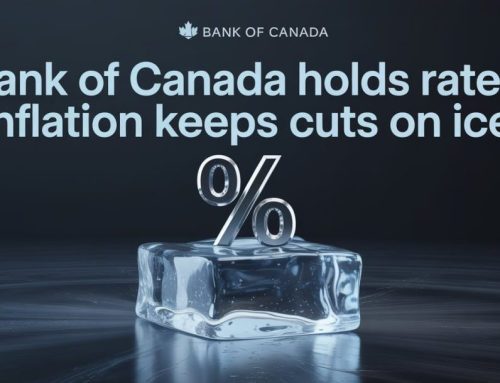If you are in a true variable rate mortgage, your payment will remain unchanged for the term. This can give peace of mind to many as it guarantees a predictable cash flow each month. When the rate increases, then a larger portion of that payment will be applied to interest with a smaller portion going to principal. However, the payment always remains the same.
But that doesn’t guarantee that you will never have to pay anything more towards your mortgage over the term.
If the prime rate continues to rise, then you can reach what’s called a trigger rate. This is the point when the mortgage payment is no longer enough to cover the interest charged.
What happens then?
The excess interest, also referred to as deferred interest, will be added to the mortgage amount owed. The balance will then continue to increase with each payment until it hits the trigger point.
What’s The Difference Between The Trigger Point And The Trigger Rate?
The trigger point and trigger rate are two different things. The trigger point is when your mortgage balance exceeds the original loan amount. This is also known as negative amortization, meaning that your amortization period is now greater than it was when your mortgage began. The trigger rate was explained above.
Your mortgage lender will generally notify you once you hit your trigger rate. Each lender can have different policies on this, but they likely won’t require you to take any action at this point. But that doesn’t mean that you should sit back and wait for your balance to climb higher than it was when your mortgage began.
What Can You Do To Protect Yourself?
There are a few things you can do at this point:
- Increase your mortgage payment
- Make a lump sum payment
- Convert to a fixed rate
Increase your mortgage payment
The additional payment required to make up for the deferred interest will vary based on your trigger rate, which can be found in your original loan agreement. Your lender should notify you once you have reached the trigger rate, along with the deferred interest amount. You can then increase your payment to make up for the additional interest. If you can comfortably afford a higher payment, then I would suggest increasing it enough to cover some of the principal as well.
Make A Lump Sum Payment
Anytime you make an additional payment toward your mortgage, it’s applied directly to the principal. This will immediately reduce your effective amortization, therefore pushing out the trigger point, or eliminating any reasonable possibility of reaching it.
Convert to a Fixed Rate
Whenever interest rates increase, I’ll always get an influx of inquiries from those in variable rate mortgages asking if they should be locking into a fixed rate. This topic alone is an entire blog in itself. If you were to choose this option, you’d be locking into one the highest fixed rates we have seen in 14 years.
As we are almost certainly going into a recession, the Bank of Canada will need to shift its focus from battling inflation to protecting the economy. This is when we can expect them to begin dropping their rate, which is forecasted to happen in 2024. Some of the major banks are now predicting a rate cut in the fourth quarter of 2023. This will result in falling bond yields, which will bring fixed mortgage rates down with them.
At that point, anyone choosing a fixed rate today will almost certainly be looking to convert to a lower rate.
However, the further fixed rates fall, the higher your penalty becomes. It can easily get to the point where the penalty makes switching cost prohibitive, leaving you stuck in the higher, fixed rate mortgage. While every situation can be a bit different and there is no one size fits all mortgage advice, I think those choosing a fixed rate mortgage today will end up regretting the choice in a couple of years.
Time will tell, and anything can happen.
When Will You Reach Your Trigger Point?
If your variable rate mortgage started between spring of 2020 through early 2022, then it’s likely that you’ll hit your trigger rate before the end of this year. The next Bank of Canada rate announcement is scheduled for September 7th when they are expected to increase their rate by another 0.50% to 0.75%.
This will be enough to push some over the trigger rate, while others may not reach it until the following announcement. That is, if the Bank of Canada increases any further. It’s possible that September 7th could be the last of the rate increases. We’ll have to wait and see.
Those with a 30 year amortization will hit the trigger rate sooner due to the original interest portion of the payment being larger.
If you have used your prepayment privileges then you are ahead of the game, and are not likely in danger of hitting your trigger rate anytime soon… depending on how aggressive you were with your prepayments.
Will You Be Forced To Increase Your Payments If You Hit The Trigger Point?
Policy can vary from lender to lender, but most should not require you to pay anything more towards your mortgage. They may make suggestions, but they won’t force you to take action as long as there is sufficient equity in the property. It’s when the equity drops below their comfort zone that they will ask you to pony up some additional funds or convert to a fixed rate.
How does a lender determine their comfort zone?
If your mortgage balance including the deferred interest were to exceed 80% of the property value (determined by the lender), then they may require you to take one of the three actions listed above.
If your mortgage was insured (meaning you had less than 20% down payment when you purchased), then their comfort zone is much higher given that they are protected by the insurer. TD for example will allow your balance to climb to 105% of the property value before requiring you to make a move.
Why Are Trigger Rates Becoming An Issue?
Trigger rates are usually not something that true variable rate mortgage holders would ever need to be concerned about. But we’re in a unique time, and no one thought rates would climb as quickly as they did. In July 2020, the Bank of Canada assured everyone by saying “It’s going to be a long climb out’ and “We are being unusually clear that interest rates are going to be unusually low for a long time”.
They were very wrong.
As with anyone making predictions about the financial markets, they can only go based on what they know at the time. But circumstances can and do change, which can then change the predictions. The COVID-19 pandemic was not something that anyone could have predicted, which significantly changed any previous economic forecasts.
Even as early as 2022, no one could have predicted that the Bank of Canada was going to start increasing their rate as aggressively as they have. At the end of January, economists were predicting four to five increases this year, with each one being for the standard 0.25%. Yet we’ve seen the BOC stack their increases going as high as 1.00% in a single announcement for a total of 2.25%. And they are not finished yet.
How could everyone be so very, very wrong?
Just as no one could predict the pandemic, no one could have predicted the war in Ukraine. It caused further disruption to the already weakened supply chain, which fueled inflation even further. Prime rate forecasts began to change as a result, leading us up to where we are today.
Conclusion
Rarely do we find ourselves in a situation where trigger rates can be… well… triggered. We’re in a unique time, however. If you’re in a true variable rate mortgage, then I would consider being proactive and either make a lump sum payment, or increase your regular scheduled payments to an amount you feel comfortable with.
As I’ve been saying since the beginning of the year, the faster the Bank of Canada increases their rate, the sooner they will need to come through with a cut.
Two of the big banks are now forecasting that they will start cutting their rate in the fourth quarter of 2023. We’ll see if the banks and other leading economists start to jump on the bandwagon.
As always, time will tell, and anything can happen.







